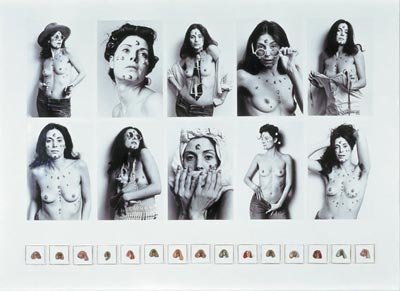4/10/2006
Hannah Wilke
Artium, Vitoria-Gasteiz
Exchange Values

Exchange Values
Curator Laura Fernandez Orgaz
Hannah Wilke belonged to the first generation of American feminist artists that came to the fore in the Seventies and who fought fiercely to secure a place for women on the artistic scene, dominated by a deep-seated patriarchal attitude. Through her art, Wilke and many other women argued in favour of the particular nature of the feminine sex and the quality of women artists as thoughtful and creative beings, in contrast to their traditional representation as a passive object. The vagina became an icon for many of them as they used it as a label to distance their art from that of their male colleagues, as well as elevating and validating the feminine sex, traditionally considered as sinful and a taboo or as a symbol of fertility (in fact, Wilke was the first artist to use vaginal iconography at the end of the Sixties). The desire to do away with the patriarchal myth of masculine genius which had contributed to the absence and suppression of women artists in the past, motivated these artists to explore new mediums and forms of expression such as performance or video, which was still in its early days.
Hannah Wilke developed as an artist within this context. In her sculptures she used both traditional materials, such as ceramics, which she employed throughout her life, and other, non-traditional materials such as chewing gum, erasers, latex and linen. Moreover, aware of the expressive potential of non-traditional mediums, she became intensely involved with a number of artistic forms such as performance, video and photography, alternating these with more traditional disciplines such as drawing.
Her own body became the centre of her art, which she used to focus on her own experiences as a vehicle to explore themes of a universal nature. In this way, through the exhibition of her naked body in actions, videos and photographs, the ambiguous and ironical use of language in the titles of her works and in numerous personal writings, she attacked the habit of labelling and stereotyping, of dominating and scorning other attitudes, races, religions and cultures (she was herself a Jew), without forgetting the feminine gender. Subjects such as the social oppression of women, the dominant masculine look -perpetrator of the feminine ideal-, the fanaticism of radical feminism, the economic value and contribution of the work of women artists and even Duchamp, whom she admired, gave rise to courageous and provocative works such as Super-T-Art, S.O.S. Starification Object Series, Marxism and Art, So Help Me Hannah, and I Object. An art capable of changing our ways of looking at things, which was seen by many as a threat…
The displaying of her young, beautiful and naked body unleashed attacks from many of her feminist colleagues of that time, who accused her of excess narcissistic exhibitionism and frivolity. Lucy Lippard, one of her most renowned critics of that time, declared that she flirted and provoked too much to be a feminist. Nevertheless, undaunted by these comments, she continued to work along the same lines and used her body throughout her life, both in her youth and later when she was mature and unwell.
In her later years, Wilke explored subjects such as the ephemeral nature of beauty, the fragility of life, illness, pain and the inevitability of death. Through her relationship with her mother, who she looked after and photographed with true passion throughout her long battle against cancer, Wilke succeeded in looking at this illness in a different light and in giving the ailing body of her mother, weakened by intense medical treatment, a different dimension. The image of Selma Butter, weak and vulnerable, is capable of conveying, despite the anguish of cancer, a special dignity that resides more in the spirit than in the transitory nature of the body. Unhappily, it would not be the last time that the artist had to face up to illness, pain and death, as, in 1987, she herself was diagnosed with lymphoma and died six years later.
The series Intra-Venus would be the result of this final, difficult challenge. Her beautiful young body, with which she denounced the injustices in society, was used once again, now disease-ridden and deformed, racked with pain and awaiting a certain death, to highlight the crude reality of her vulnerability and ephemeral passage through life. It is as if Intravenus were the final piece in a jigsaw puzzle in which everything fits together with a moving coherence, as if it were a legacy bequeathed by the artist to a society that longed to be more tolerant.
Image: S.O.S. Starification Object Series, 1974-82. 10 black-and-white photographs, 15 gum sculptures 104,14 x 147,32 x 7,62 cm. Private Collection. Courtesy of Ronald Fine Arts, New York
Lower East Gallery
ARTIUM de A'lava
Calle Francia 24, 01002 Vitoria-Gasteiz
Opening hours 11.00 to 20.00
Fridays and Saturdays, 11.00 to 20.30
Mondays, closed
Admission
General 4,50 €
Concession 2,20 €
14 years or lower 0,00 €
Groups (general fee) 4,00 €
Special price for groups 2,00 €



